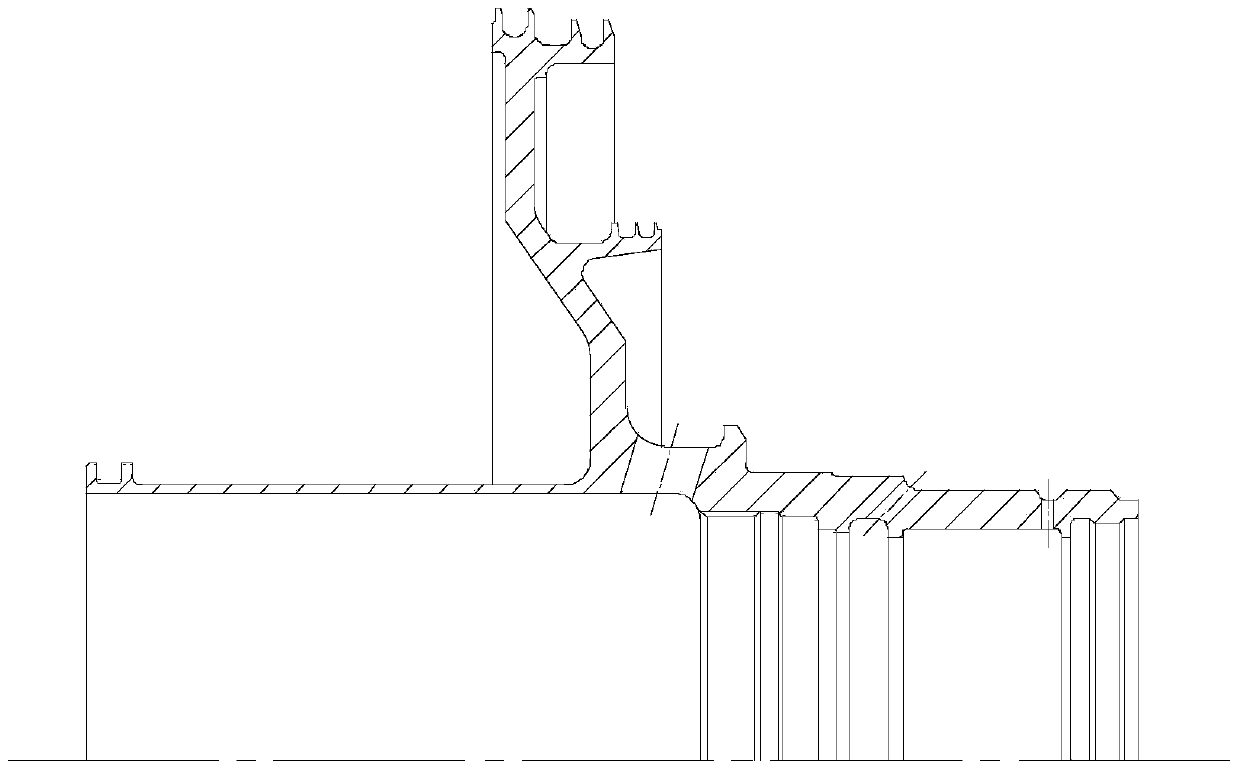Machining method for rear shaft neck of aerial turbofan engine
A technology of a turbofan engine and a processing method, which is applied in the field of precision machining of aero-engine parts, can solve the problems of high processing cost, plastic deformation, and low processing accuracy, and achieves the effect of ensuring processing efficiency and quality.
- Summary
- Abstract
- Description
- Claims
- Application Information
AI Technical Summary
Problems solved by technology
Method used
Image
Examples
Embodiment 1
[0036] Embodiment 1: Die forging is used to process the GH4698 alloy into a blank, check the dimensions of the blank by marking lines, determine whether the blank is qualified, and draw a reference line for processing. Rough machining: clamp the outer tube wall at the left end of the blank, rough turn the outer circular surface and end face at the right end of the blank, rough bore the inner hole, and remove the remaining material; clamp the outer tube wall at the right end of the blank, correct the inner hole, and rough turn the blank The outer circular surface and end surface of the left end, the inner hole is roughly bored, and the remaining material is removed, leaving a machining allowance of 2mm for each single side. Flaw detection: Ultrasonic flaw detector is used for detection to find parts defects and determine the quality of parts. Semi-finishing: special mandrel inner hole positioning and clamping, semi-finishing blank right end outer circular profile, outer circula...
Embodiment 2
[0037] Embodiment 2: Die forging is used to process the GH4698 alloy into a blank, check the dimensions of the blank by marking lines, determine whether the blank is qualified, and draw a reference line for processing. Rough machining: clamp the outer tube wall at the left end of the blank, rough turn the outer circular surface and end face at the right end of the blank, rough bore the inner hole, and remove the remaining material; clamp the outer tube wall at the right end of the blank, correct the inner hole, and rough turn the blank The outer circular surface and end surface of the left end, the inner hole is roughly bored, and the remaining material is removed, leaving a machining allowance of 2mm for each single side. Flaw detection: Ultrasonic flaw detector is used for detection to find parts defects and determine the quality of parts. Semi-finishing: special mandrel inner hole positioning and clamping, semi-finishing blank right end outer circular profile, outer circula...
Embodiment 3
[0038]Embodiment 3: Die forging is used to process the GH4698 alloy into a blank, check the dimensions of the blank by marking lines, determine whether the blank is qualified, and draw a reference line for processing. Rough machining: clamp the outer tube wall at the left end of the blank, rough turn the outer circular surface and end face at the right end of the blank, rough bore the inner hole, and remove the remaining material; clamp the outer tube wall at the right end of the blank, correct the inner hole, and rough turn the blank The outer circular surface and end surface of the left end, the inner hole is roughly bored, and the remaining material is removed, leaving a machining allowance of 2mm for each single side. Flaw detection: Ultrasonic flaw detector is used for detection to find parts defects and determine the quality of parts. Semi-finishing: special mandrel inner hole positioning and clamping, semi-finishing blank right end outer circular profile, outer circular...
PUM
| Property | Measurement | Unit |
|---|---|---|
| hardness | aaaaa | aaaaa |
| hardness | aaaaa | aaaaa |
Abstract
Description
Claims
Application Information
 Login to View More
Login to View More - R&D
- Intellectual Property
- Life Sciences
- Materials
- Tech Scout
- Unparalleled Data Quality
- Higher Quality Content
- 60% Fewer Hallucinations
Browse by: Latest US Patents, China's latest patents, Technical Efficacy Thesaurus, Application Domain, Technology Topic, Popular Technical Reports.
© 2025 PatSnap. All rights reserved.Legal|Privacy policy|Modern Slavery Act Transparency Statement|Sitemap|About US| Contact US: help@patsnap.com

